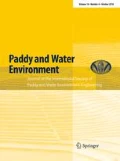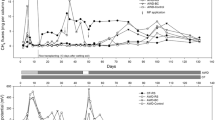Abstract
Methane oxidation activity (MOA), methanotrophic bacteria (MOB), and CH4 emission in a paddy field fertilized with anaerobically digested slurry were compared between two varieties: a fodder rice variety Leaf star (LS) and a normal rice variety Kinuhikari (KN). Average MOA and MOB per unit dry root were significantly higher in KN (7.1 μmol g−1 CH4 g−1 dry root h−1 and 3.7 × 107 MPN g−1 dry root, respectively) than in LS (4.3 μmol g−1 CH4 g−1 dry root h−1, 2.1 × 107 MPN g−1 dry root), although MOA in the rice root per whole plant was not significantly different since root biomass of LS (1.5 g dry root plant−1) was significantly higher than that of KN (1.2 g dry root plant−1). MOA in the soil ranged from 0.031 to 0.087 μmol g−1 CH4 g−1 dry soil h−1, but there were no significant differences in both depths (0–5 and 5–15 cm) between the two rice varieties. MOA in the rhizosphere soil was significantly different between the rice varieties at flowering, but not at tillering. Methane emission in the field was lower and MOA and MOB in the rice root were higher in LS than in KN at tillering, but the reverse results were found at flowering and maturity stages. Total CH4 emission during a growing period was not significantly different between LS (27.4 ± 16.9 g CH4 m−2) and KN (24.0 ± 19.5 g CH4 m−2). There was a significant negative relationship between CH4 emission and rice root MOB (P < 0.01) or MOA (P < 0.05) and significant positive relationship was observed between root MOA and MOB (P < 0.01). This study revealed that choice of rice variety might be an important environmental issue in paddy cultivation since it can influence MOA and MOB in rice root and rhizosphere soil which relate with CH4 emission.




Similar content being viewed by others
References
Aulakh MS, Bodenbende J, Wassmann R, Renenberg H (2000) Methane transport capacity of rice plants. I. Influence of methane concentration and growth stage analyzed with an automated measuring system. Nutr Cycling Agroecosys 58:357–366
Butterbach-Bahl K, Papen H, Rennenberg H (1997) Impact of transport through rice cultivars on methane emission from rice paddy fields. Plant Cell Environ 20:1175–1183
Conrad R, Rothfus F (1991) Methane oxidation in the soil surface layer of a flooded rice field and the effect of ammonium. Biol Fertil Soils 12:28–33
Dubey SK (2003) Spatio-kinetic variation of methane oxidizing bacteria in paddy soil at mid-tillering: effect of N-fertilizers. Nutr Cycling Agroecosys 65:53–59
Dubey SK, Singh JS (2000) Spatio-temporal variation and effect of urea fertilization on methanotrophs in a tropical dryland rice field. Soil Biol Biochem 32:221–226
Eller G, Frenzel P (2001) Changes in activity and community structure of methane oxidizing bacteria over the growth period of rice. Appl Environ Microbiol 67:2395–2403
Galchenko VF, Lein A, Ivanov M (1989) Biological sinks of methane. In: Andreae MO, Schimel DS (eds) Exchange of trace gases between terrestrial ecosystems and the atmosphere. John Wiley & Sons, New York, pp 59–71
Gilbert B, Frenzel P (1998) Rice roots and CH4 oxidation: the activity of bacteria, their distribution and the microenvironment. Soil Biol Biochem 30:1903–1916
Hou H, Zhou S, Hosomi M, Toyota K, Yosimura K, Mutou Y, Nisimura T, Takayanagi M, Motobayashi T (2007) Ammonia emissions from anaerobically digested slurry and chemical fertilizer applied to flooded forage rice. Water Air Soil Pollut 183:37–48
Intergovernmental Panel on Climate Change (1992) Climate change 1992. The supplementary report to the IPCC scientific assessment. Cambridge Univ. Press, Cambridge
Inubushi K, Sugii H, Nishono S, Nishino E (2001) Effect of aquatic weeds on methane emission from submerged paddy soil. Am J Bot 88:975–979
Inubushi K, Sugii H, Watanebe I, Wassmann R (2002) Evaluation of methane oxidation in rice plant-soil system. Nutr Cycling Agroecosys 64:71–77
Kerdchoechuen O (2005) Methane emission in four rice varieties as related to sugars and organic acids of roots and root exudates and biomass yield. Agri Ecosyst Environ 108:155–163
Kyaw KM, Toyota K, Okazaki M, Motobayashi T, Tanaka H (2005) Nitrogen balance in a paddy field planted with whole crop rice (Oryza sativa cv. Kusahonami) during two rice-growing seasons. Biol Fertil Soils 42:72–82
Lüke C, Krause S, Cavigiolo S, Greppi D, Lupotto E, Frenzel P (2010) Biogeography of wetland rice methanotrophs. Environ Microbiol 12:862–872
Ma KE, Qiu Q, Lu Y (2010) Microbial mechanism for rice variety control on methane emission from rice field soil. Global Change Biol. doi:10.1111/j13652486200902145
Minamikawa K, Sakai N (2006) The practical use of water management based on soil redox potential for decreasing methane emission from a paddy field in Japan. Agri Ecosyst Environ 116:181–188
Mosier A, Wassmann R, Verchot L, Khing J, Palm C (2004) Methane and nitrogen oxide fluxes in tropical agricultural soils. Environ Dev Sustain 6:11–49
Nayak DR, Babu YJ, Datta A, Adhya TK (2007) Methane oxidation an intensively cropped tropical rice field soil under long-term application of organic and Mineral Fertilizers. J Environ Qual 36:1577–1584
Ookawa T, Yasuda K, Kato H, Sakai M, Seto M, Sunaga K, Motobayashi T, Tojo S, Hirasawa T (2010) Biomass production and lodging resistance in ‘Leaf star’, a new long-culm rice forage cultivar. Plant Prod Sci 13:58–66
Sass RL, Fisher FM, Harcombe PA (1991) Mitigation of methane emissions from rice fields: possible adverse effects of incorporated rice straw. Glob Biogeochem Cycles 5:275–287
Satpathy SN, Mishra S, Adhya TK, Ramakrishnan B, Rao VR, Sethunathan N (1998) Cultivar variation in methane efflux from tropical rice. Plant Soil 202:223–229
Sunaga K, Yoshimura N, Hou H, Win KT, Tanaka H, Yoshikawa M, Watanabe H, Motobayashi T, Kato M, Nishimura T, Toyota K, Hosomi M (2010) Impacts of heavy application of anaerobically digested slurry to whole crop rice cultivation in paddy environment on water, air and soil qualities. Jpn J Soil Sci Plant Nutr 80:596–605 (in Japanese with English summary)
Takeda K, Tonouchi A, Takada M, Suko T, Suzuki S, Kimura Y, Matsuyama N, Fujita T (2008) Characterization of cultivable methanotrophs from paddy soils and rice roots. Soil Sci Plant Nutr 54:876–885
Vishwakarma P, Dubey SK (2007) The effect of soil type and plant age on the population size of rhizospheric methanotrophs and their activities in tropical rice soils. J Basic Microbiol 47:351–357
Vishwakarma P, Dumont MG, Bodrossy L, Stralis-Pavese N, Murrell JC, Dubey SK (2009) Ecological and molecular analyses of the rhizospheric methanotroph community in tropical rice soil: effect of crop phenology and land-use history. Curr Sci INDIA 96:1082–1089
Wang B, Adachi K (2000) Differences among rice cultivars in root exudation, methane oxidation, and populations of methanogenic and methanotrophic bacteria in relation to methane emission. Nutr Cycling Agroecosys 58:349–356
Wassmann R, Aulakh MS (2000) The role of rice plants in regulating mechanisms of methane emissions. Biol Fertil Soils 31:20–29
Win KT, Toyota K, Motobayashi T, Hosomi M (2009) Suppression of ammonia volatilization from a paddy soil fertilized with anaerobically digested cattle slurry by wood vinegar application and floodwater management. Soil Sci Plant Nutr 55:190–202
Win KT, Nonaka R, Toyota K, Motobayashi T, Hosomi M (2010) Effects of option mitigating ammonia volatilization on CH4 and N2O emissions from a paddy field fertilized with anaerobically digested cattle slurry. Biol Fertil Soils 46:589–595
Yoon CG (2009) Wise use of paddy rice fields to partially compensate for the loss of natural wetlands. Paddy Water Environ 7:357–366
Zhang G, Zhang X, Ma J, Xu H, Cai Z (2011) Effect of drainage in the fallow season on reduction of CH4 production and emission from permanently flooded rice fields. Nutr Cycling Agroecosys 89:81–91
Acknowledgments
This study was supported by Japan Science and Technology (JST) and National Natural Science Foundation of China (NSFC). The authors thank Dr. Masanori Okazaki, Dean, Bio-Applications and Systems Engineering, Tokyo University of Agriculture and Technology (TUAT) for permitting of analysis of C and N for soil and Dr. Kimura Sonoko D., Associate Professor, TUAT, for her supporting of Plexiglas chambers.
Author information
Authors and Affiliations
Corresponding author
Rights and permissions
About this article
Cite this article
Win, K.T., Nonaka, R., Win, A.T. et al. Comparison of methanotrophic bacteria, methane oxidation activity, and methane emission in rice fields fertilized with anaerobically digested slurry between a fodder rice and a normal rice variety. Paddy Water Environ 10, 281–289 (2012). https://doi.org/10.1007/s10333-011-0279-x
Received:
Revised:
Accepted:
Published:
Issue Date:
DOI: https://doi.org/10.1007/s10333-011-0279-x




